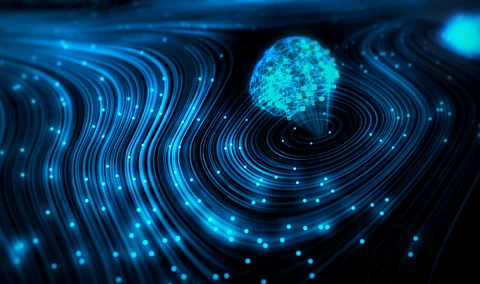
- Insights
- Cryptocurrencies
- Gadgets
- Stocks
- White Papers
- Reports
- Industry
- Geography
- Insights
- Cryptocurrencies
- Gadgets
- Stocks
- White Papers
- Reports
- Industry
- Geography

Artificial intelligence (AI) has spread its innovative tendrils through all aspects of our daily lives, advancing faster than we can yet comprehend, but there is a bottleneck — software innovation.
Although the fundamental computational power of AI rests upon the foundation of its sophisticated hardware base, AI only truly shines when it meets harmoniously with efficient software design. Combined with infrastructure management that fully unlocks its potential, AI can thrive — unlike the modern software confines found and employed by users around the world.
With the right software, it’s possible to break the limitations of AI and impact how effective AI models can truly become. As the result of advancements in software innovation seen in projects like NeurochainAI, these limitations are overcome and AI models made significantly more efficient on smaller devices.
Within the last five or 10 years, AI has taken a number of strides in technological advancement — much of it attributed to software, not hardware upgrades. Specific tweaks, improvements and innovative changes to software have made it possible to train and utilize AI models on devices previously lacking the computational power requirements.
Three specific innovations that have unlocked this reality include distributed computing frameworks, efficient algorithms, and model quantization.
These specific frameworks lay the foundations for the distribution of computational tasks and endeavors across several devices, efficiently utilizing their combined power towards greater concentrated goals.
This approach is both faster than the unorganized scattered computational power method and is decentralized, creating a faster, less demanding process for each machine involved.
An element that seems to evolve year after year — algorithms. As a crucial part of software innovation, the use of increasingly more efficient algorithms steadily reduces resource consumption while optimizing performance.
This approach can include techniques like pruning to remove redundant parameters from an AI model and knowledge distillation, which involves smaller models being trained to mimic larger models.
This is a process that decreases the number of bits necessary to represent a model’s parameters, which as a result, reduces its size and improves how efficiently it can perform. This process allows AI models to run on consumer-grade hardware like laptops or smartphones.
This approach helps to decrease the precision of model weights as quantization drastically reduces the amount of memory and computational power required — without substantially compromising AI accuracy.
NeurochainAI demonstrates the potential locked behind stagnant software through its decentralized infrastructure and its innovative approach to handling software efficiency. The layer 1 decentralized AI (DE-AI) solution enables the building, deploying, and hosting of AI decentralized applications (dApps) powered by the community but designed for all users.
Through the use of its community-powered DE-AI and consumer hardware decentralized physical infrastructure network (DePIN), NeurochainAI is shifting power from centralized entities back into the hands of the people.
By involving the community in every step, NeurochainAI ensures users are present in every step, from the collection and validation of data to the creation and validation of AI models. Through this crowd-sourced methodology, NeurochainAI maintains data security and diversity while also incentivizing the community by aptly rewarding their contributions.
Two elements are present in NeurochainAI that set it apart from all the rest, its Consumer Hardware DePIN and AI Mining.
NeurochainAI takes an open approach to AI software innovation through their DE-AI marketplace, allowing community members to share and monetize AI models. Through advanced segmentation and intelligent tagging, the marketplace streamlines the process for developers to discover and integrate tailored AI solutions, thereby fostering rapid software innovation and enhancing technological advancements in various applications. The marketplace identifies and recommends the most suitable models based on a developer's requirements, refining the model selection process as targeted software solutions reach the needs of individuals and firms.
Through the Consumer Hardware DePIN, users only need a graphics processing unit (GPU) to connect and become a part of the decentralized network and contribute to AI computation. By rewarding contributors, and ultimately the community, NeurochainAI taps into the expanse of underutilized computational power of consumer hardware for AI software innovation.
Hardware present a baseline for the raw power required to sustain AI and is vital to its use and development, but only through software innovation can this raw power be shaped. NeurochainAI is doing this through its layered decentralized AI as a Service (DeAIAS), maximizing hardware through the potential of software.
NeurochainAI’s platform is capable of performing AI computations by utilizing its decentralized network to create a transparent and endlessly scalable optimized design. Through this process, AI tasks are powered by the collective computational power — rather than solely one machine's hardware capacity — and distributed efficiently.
Unlike traditional AI development, NeurochainAI’s Consumer Hardware DePIN overcomes the resource-demanding and time-consuming processes of the past without sacrificing trust or security. By using software to optimize hardware, NeurochainAI reduces development time by over 90% — saving resources, time, and unlocking new levels of potential development.
Through NeurochainAI’s Consumer Hardware DePIN, gone are the days of up to 120 hours required for development times as its design reduces all costs and drops development time to just 5-9 hours. This cost-effective and 25 times faster method helps to make AI accessible to any user and any business of any size — globally and decentralized.
As AI grows roots in our everyday tasks, job roles, and free time leisure activities, the last important aspect to consider is sustainability — something NeurochainAI takes seriously. Rather than solely focusing on the limitations and the necessity to regularly upgrade hardware, NeurochainAI builds the software required to reduce computational load and optimize the entire process.
By utilizing existing hardware, rewarding community participation and promoting distributed and decentralized AI development, NeurochainAI ensures a sustainable and inclusive future.
